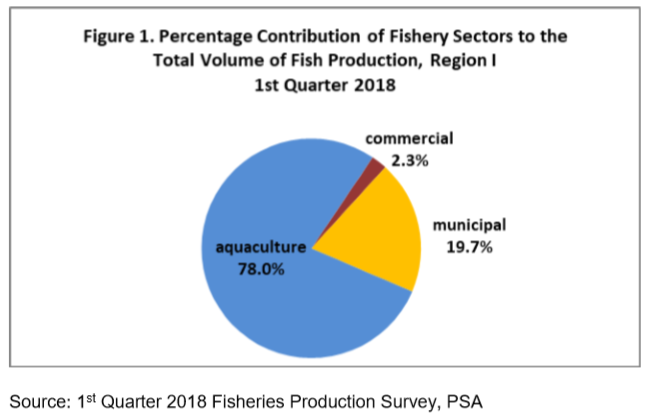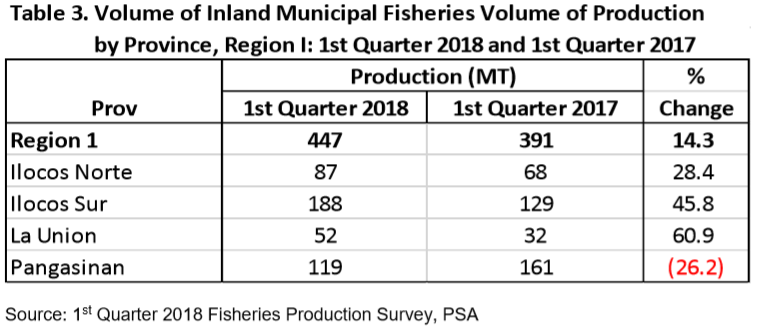The overall fisheries production in Region I went up by 4.9 percent in 1st quarter 2018. From the total output of 28,630 metric tons in 1st quarter 2017, it grew to 30,021 metric tons this 1st quarter 2018. All the provinces posted increases in output, except La Union.
The aquaculture sub-sector pulled up the overall fisheries production of the region. It contributed 78.0 percent to fisheries output. The municipal and commercial fisheries, both posted lower growths, accounted 19.7 percent and 2.3 percent, respectively.

In terms of provincial distribution, the province of Pangasinan shared the bulk of production of about 84.0 percent in 1st quarter 2018. The production of its aquaculture sub-sector grew by 11.0 percent, while the commercial and municipal sub-sectors of the province went down by 65.0 percent and 9.1 percent, respectively. The overall production of Pangasinan was posted at 25,216 metric tons, or 5.1 percent higher than its production in the same period of 2017.


The province of La Union registered lower overall fisheries production in 1st quarter 2018 as compared with the 1st quarter 2017 level. The decline in the production of the aquaculture sub-sector caused the lower growth in the overall output. From the 1,788 metric ton production last year, it went down to 1,733 metric tons this year.
The fisheries production of Ilocos Sur, which shared 5.3 percent to the total fisheries output of the region, registered positive growth in 1st quarter 2018. Its production was recorded at 1,605 metric tons, or 1.8 percent higher than the production in 1st quarter 2017 of 1,577 metric tons.
The fisheries production of Ilocos Norte, which shared 4.9 percent to the total fisheries output of Region I, went up by 15.7 percent in 1st quarter 2018. Its output was posted at 1,467 metric tons, higher than the output in the same period in 2017 of 1,268 metric tons. This was contributed by the increased production in the aquaculture sub-sector. Meanwhile, the municipal fisheries production of the province recorded lower output as compared with the production a year ago.
Commercial Fisheries The commercial fisheries volume of production in Region I went down by 42.1 percent in first quarter 2018. Its output was posted at 696 metric tons, lower than the output in the same period in 2017 of 1,202 metric tons. The provinces of Ilocos Sur and Pangasinan posted lower production. The number of fishing vessels that usually unload in Sual Fish Port decreased. Also, there were lesser fishing days due to long period of northeasterly winds, coupled with lesser school of fish
In terms of provincial shares, Pangasinan accounted for 46.4 percent of the region’s commercial fisheries volume of production in first quarter 2018. It was followed by La Union with 45.8 percent share, and Ilocos Sur at 7.8 percent share.

The top five major catch in the region during the 1st quarter 2018 were Skipjack, Threadfin bream, Roundscad, Hairtail, and Indo-pacific mackerel.

Municipal Fisheries
The overall municipal fisheries production of Region I in 1st quarter of 2018 declined by 5.0 percent. The overall production was posted at 5,909 metric tons, lower than the output in 1st quarter 2017 of 6,223 metric tons. The lesser catch in the marine municipal fisheries contributed to the overall decrement in output of the sub-sector.
Marine Municipal
Production of Marine Municipal Fisheries in Region I in 1st quarter 2018 was posted at 5,462 metric tons, lower than the output in 1st quarter 2017 of 5,832 metric tons. All the provinces of the region, except La Union, posted lower output. Lesser school of fish and fishing operations were observed due to prolonged northeast monsoon. Some fishing vessels in Pangasinan were dry docked for repair.

The province of Pangasinan contributed 58.0 percent to the region’s marine municipal fish catch for the first quarter 2018, followed by Ilocos Sur with 21.9 percent share, Ilocos Norte with 13.6 percent share, and La Union with 6.4 percent. The dominant catch in marine municipal waters during the period were Squid, Skipjack, Yellowfin tuna, Siganid, and Cavalla.


Source: 1st Quarter 2018 Fisheries Production Survey, PSA
Inland Municipal Fisheries
Production of Inland Municipal Fisheries in Region I grew by 14.3 percent in 1st quarter 2018. From its output of 391 metric tons in the same period last year, it went up to 447 metric tons this year. All the provinces, except Pangasinan, posted higher output. More fishing operations and fish shelters set, and bigger sizes of catch contributed to the overall increase in production.

By province, Ilocos Sur ranked first in the volume of production of Inland municipal fisheries during the 1st quarter 2018 with 42.1 percent share. It was followed by Pangasinan with 26.7 percent share, Ilocos Norte with 19.6 percent, and La Union 11.7 percent. The top five major catch in the region during the period 2018 were Tilapia, Freshwater goby, Endeavor prawn, Freshwater shrimp, and Carp.


Source: 1st Quarter 2018 Fisheries Production Survey, PSA
Aquaculture
Aquaculture production of Region I increased by 10.4 percent in 1st quarter 2018. From its output of 21,206 metric tons in the same period last year, it went up to 23,415 metric tons this year. The provinces of Pangasinan and Ilocos Norte posted positive growths in output. The overall increment in production could be attributed to increased stocking density, bigger size of catch, and increased harvesting during the Lenten season. The province of Pangasinan shared the bulk of aquaculture production with 92.3 percent. By culture type, aquaculture in Region I was dominated by Marine cage which accounted for 62.1 percent of the total production.


Milkfish dominated the aquaculture production of Region I with a share of 88.3 percent. Its production in the 1st quarter 2018 was posted at 20,666 metric tons, higher than its output in the same quarter last year of 18,473 metric tons. Increased stocking density, increased harvesting during the Lenten season, and bigger sizes of harvest were the factors that contributed to the higher production.

TECHNICAL NOTES
The Fisheries Production Survey of the Philippine Statistics Authority (PSA) is divided into four (4) major fisheries surveys. These are the Quarterly Commercial Fisheries Survey (QCFS), Quarterly Municipal Fisheries Survey (QMFS), Quarterly Inland Fisheries Survey (QIFS) and Quarterly Aquaculture Survey (QAqS). The commercial and municipal fisheries surveys aim to provide quarterly data on volume and value of fish production by species, by region and by province. The aquaculture survey is intended to generate quarterly data on volume and value of cultured species by environment, by type of aquafarm, by region and by province.
Concepts and Definitions:
Aquaculture – fishery operation involving all forms of raising and culturing of fish and other fishery species in marine, brackish and fresh water environment. Examples are fishponds, fish pens, fish cages, mussel, oyster, seaweed farms and hatcheries.
Aquafarm – the farming facilities used in the culture or propagation of aquatic species including fish, mollusk, crustaceans and aquatic plants for purposes of rearing to enhance production.
Brackishwater – mixture of seawater and freshwater with salinity that varies with the tide.Example are estuaries, mangroves and mouths of rivers where seawater enters during high tide.
Commercial Fishing – the catching of fish with the use of fishing boats with a capacity of more than three (3) gross tons for trade, business or profit beyond subsistence or sports fishing.
Fisheries – all activities relating to the act or business of fishing, culturing, preserving, processing, marketing, developing, conserving and managing aquatic resources and the fishery areas including the privilege to fish or take aquatic resources thereof (RA 8550).
Fisheries Sector – the sector engaged in the production, growing, harvesting, processing, marketing, developing, conserving and managing of aquatic resources and fishing areas.
Fish Cage – stationary or floating fish enclosure made of synthetic net wire/bamboo screen or other materials set in the form of inverted mosquito net (“hapa” type) with or without cover with all sides either tied to poles staked to the water bottom or with anchored floats for aquaculture purposes.
Fishing Gear – any instrument or device and its accessories utilized in taking fish and other fishery species.
Fishing Grounds – areas in any body of water where fish and other aquatic resources congregate and become target of capture.
Fish Pen – an artificial enclosure constructed within a body of water for culturing fish and fishery/ aquatic resources made up of bamboo poles closely arranged in an enclosure with wooden materials, screen or nylon netting to prevent escape of fish.
Fishpond – a body of water (artificial or natural) where fish and other aquatic products are cultured, raised or cultivated under controlled conditions. This is a land-based type of aquafarm. Note that the setting-up of fish cages in ponds does not make the operation of fish cage and at the same time a fishpond.
Freshwater – water without salt or marine origin, such as generally found in lakes, rivers, canals, dams, reservoirs, paddy fields and swamps.
Inland Municipal Fishing – the catching of fish, crustaceans, mollusks and all other aquatic animals and plants in inland water like lakes, rivers, dams, marshes, etc. using simple gears and fishing boats some of which are nonmotorized with a capacity of three (3) gross tons or less; or fishing not requiring the use of fishing boats.
Landing Center – place where the fish catch and other aquatic products are unloaded and traded.
Municipal Fishing – covers fishing operation carried out with or without the use of a boat weighing three (3) gross tons or less.
SGD. SOCRATES L. RAMORES
Regional Director

